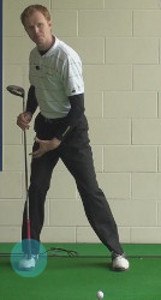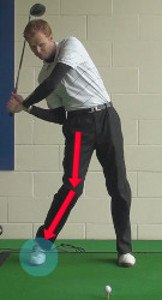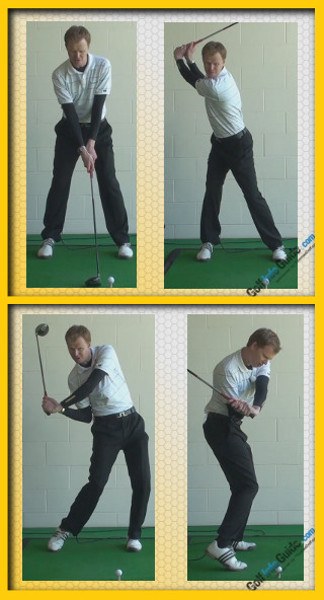
The golf world got what it was waiting for, and then some, at the 2011 U.S. Open. When Rory McIlroy, just 22 at the time, ran away with an eight-shot victory at Congressional Country Club, he fulfilled the prophecies of greatness that had followed him from an early age.
Not content to rest on his laurels, the Northern Irishman claimed the No. 1 spot in the World Golf Ranking early in 2012, and appears destined for an extraordinary career. McIlroy's talent is as stunning as an Irish links at sunset. At just 5'9”, he drives the ball outrageous distances with a natural, flowing swing that some consider one of the best in golf – ever.
McIlroy's signature: Weight shifts dramatically to his right side on the backswing.

Who else does it: Dustin Johnson, many other tour pros
One way McIlroy gets so much power from his small frame is by making an extremely wide arc on the backswing. In extending the arms and clubhead as far from the ball as possible, he positions a large percentage of his weight on the right side at the top. While McIlroy doesn't quite reach the Curtis Strange “sway” position, he comes closer than most.
Why it works for McIlroy: You'll notice that, like Strange, McIlroy remains poised over the inside of his right foot as he completes the backswing. This creates a maximum coiling effect between his upper and lower body, a key to generating power. If his weight shifted to the outside of the right foot, this tension would be lost and he'd struggle to rotate back to the left sufficiently on the downswing.

McIlroy maintains great knee flex as he turns back, which keeps his lower body stable. On the downswing, his right knee “kicks” toward the target, unleashing all the energy stored by his backswing coil. He also stays “behind” the ball, rotating to his left rather than shifting too far laterally.
How it can work for you: First of all, don't worry too much about keeping your head from moving away from the ball on the backswing. A little shifting is fine, even unavoidable; trying to prevent it causes swing-shortening tension.
What you really want is a 90° turn of the shoulders (relative to the target line) paired with a hip turn of 45° or less at the top of the backswing. Even if you can't quite hit these marks, you can still achieve a powerful coiling action – as long as your weight doesn't shift to the outside of your right (back) foot.
This simple practice drill will help you groove this coveted motion:
1. Using any club, stand with the outer edge of your right foot on top of a golf ball or similar object.
2. Make your normal swing.
The object under foot should be just large enough to inhibit your balance from moving past the right instep. If you tend to move laterally on the backswing, rather than rotating around the spine, you'll struggle to reach your standard position at the top.

Rory McIlroy – Big Weight Shift to the Right
When you have had the kind of success that Rory McIlroy has had early in his professional golf career, it is inevitable that countless amateur players will attempt to copy your swing. And, of course, there is a good reason for that fact. McIlory has one of the very best golf swings in the world, and it is easy to understand why any golfer would love to swing like one of the top players in the game. With an incredible combination of power and control, McIlroy is poised to place his name in the golf record books time after time for years to come.
Of course, any player attempting to copy McIlroy's swing in their own game is going to be in for a quick – and harsh – reality check. It isn't as easy as just copying the positions in McIlroy's swing and calling it a day. It has taken a lifetime for McIlroy to be able to play at such a high level, so the average amateur player is not going to be able to recreate his success after just a few range sessions. In fact, it is a safe bet that any amateur player trying to copy Rory's swing will never manage to rise to his level of proficiency and performance.
With that said, there are certainly things you can learn from by watching his technique – especially with the driver. McIlroy is an incredible driver of the golf ball, matching up distance and accuracy like few players in the history of the game. By picking out small elements of his driver swing technique to use in your own game, you do stand to potentially improve your driving in the relatively near future. You shouldn't expect miraculous results, but it is very much possible to take steps forward as you work toward lowering your scores.
In this article, we are going to look at one specific element of Rory's technique that you may be able to use in order to help your own driver swing – his shift to the right side. As the swing gets going, Rory does an excellent job of getting set into his right side prior to making his big shoulder turn. This is a move that not all golfers make, but it can allow you to tap into some serious power potential when you do include it in your game. When executed correctly, setting your weight into your right side as you prepare for the backswing can promote an impressive turn which will set the stage for a powerful downswing.
As you might suspect, this is a move that can also go wrong. When overdone, moving your weight into your right side can cost you your balance, and you are unlikely to be able to recover the swing from such a mistake. The title of this article refers to the move as a 'big weight shift', but that refers more to the importance of the move rather than its size. In reality, the shift is rather subtle, and might even be missed by the untrained eye. So, as you are working on this point in your own game, be sure to remember that a dramatic weight shift is going to do more harm than good to your swing.
All of the content below is written from the perspective of a right handed golfer. If you play left handed, please take a moment to reverse the directions as necessary.

Advantages of Shifting Right
You may already know that the golf swing should be mostly rotational in nature. That remains true, even if you do decide to add a bit of a right shift to your action. If you watch a video of Rory McIlroy swinging the golf club, you will notice that the majority of his movement is rotational rather than lateral. He makes a great shoulder turn in the backswing, and then uses his lower body powerfully to rotate to the left through the shot. The majority of the power that is created in a good golf swing is going to come from the rotation of the body.
With that said, there are some benefits to be associated with a slight shift to the right early in the swing. When a controlled shift is combined with great rotation, impressive results become possible. Consider the following potential benefits if you are thinking about adding a shift to the right to your golf swing.
- Staying behind the ball. A common problem for amateur golfers is sliding past the ball to the left during the downswing. This is an especially common problem when hitting the driver, although it can happen with any of the clubs in your bag. If you allow yourself to slide left as the downswing begins, you may be past the ball with your body before you arrive at impact. The result is weak contact and a shot that usually travels off-line. By shifting slightly right early in the backswing, you can position yourself to stay nicely behind the ball throughout the downswing. When impact arrives, you will be able to deliver the full-force of your swing into the back of the ball. Have you ever wondered how Rory McIlroy is able to deliver such a powerful blow despite is relatively small frame? A big part of the equation is his ability to stay behind the ball. There is no power wasted when it strikes a shot with the driver – all of his power is passed through the club and into the ball.
- Create some rhythm. One of the best things about using a slight shift to the right during your backswing is the fact that this shift can help you to produce a bit of rhythm in your swing. It can be hard to get the swing going for some amateur players, as it is difficult to transition from the static address position to the dynamics of the swing. A shift can help you get over that hurdle. By starting your backswing with a quick shift into your right side, you will have a 'trigger' that can be used to get everything moving properly. It is important to keep your swing as rhythmic and smooth as possible, and the shift to the right might be just the way to get that done.
- Engage your lower body. The average amateur golfer does not do a good job of engaging his or her lower body in the golf swing. Most players swing the club by using their hands and arms only, with very little input from the rest of the body. When you use a shift, you will naturally have to get your lower body involved early on in the swinging process. With your legs in on the action, you will be able to make a more powerful, more consistent swing time after time. Rory McIlroy does a great job of using his lower body to create speed in the swing, and you can do the same in your own game.
- Extend your backswing. You may find that you are able to make a longer backswing when you use this right shift to get your body moving in the backswing. If you try to stay perfectly still with most of your body while you turn away from the target, there will be tension in your swing and the turn will likely fall short of its potential. Of course, having your turn come up short is a sure way to lose power on your shots. With just a small shift to the right, you may be able to make a slightly longer swing, which will in turn add speed through the hitting area. Tension is never a good thing in golf, and using the right shift may be a way for you to remove some of the tension from your action.
If you do try using the shift in your own swing, you may or may not experience all of the advantages included in the list above. However, even if you are only able to take advantage of a couple of those points, you still may find the move to be a worth addition to your technique.

Making It Happen
At this point, there is really nothing left to do other than putting this move into action to see if it can help you play better golf. You already understand a few of the advantages of this technique, and you have seen how it has been effective in the swing of Rory McIlroy, one of the best golfers in the world. Nothing about your golf game is going to get better without action, so take some time to test this move out for yourself during one of your upcoming practice sessions.
It will be helpful to think of this move as something that actually happens before the backswing begins. In other words, you can think of it as a bridge between the address position and the backswing. For an outline of the proper timing of this move, review the following sequence –
- Before anything gets started in your swing, you need to go through a complete pre-shot routine. This is an important step, and one that should not be taken for granted. Many amateur golfers fail to work their way through a good pre-shot routine, and their results suffer in the end. A good routine will include club selection, target selection, a brief practice swing or motion, and anything else that prepares you mentally to hit a good shot.
- The end of your pre-shot routine is marked when you take your stance over the ball. You should work hard to take the same stance time after time, and you always want to make sure that you are aligned correctly with your target before starting your swing. Many shots are doomed to fail right from the beginning because the player fails to set up correctly, so make sure you aren't putting yourself in a bad position from which to swing.
- With your stance completed and the club head placed down behind the ball, now is the time to employ your new shift to the right. To do so, simply shift some of your weight into your right side. The best way to think about this move is by trying to move your weight onto the inside of your right foot. If you allow your weight to get out over the outside of your right foot, you will have gone too far and you will lose your balance quickly after the swing begins. Think about 'aiming' for the inside of your right foot with your weight shift, and keep your right knee in tight during the move.
- Once you have moved your weight just slightly to the right, you can go ahead and put the club in motion. Remember to avoid getting in a rush at this point – your takeaway should be gradual, smooth, and even in tempo. Countless amateur players rush through this part of the swing, making it difficult to maintain good timing all the way back down to impact. The ball isn't going anywhere, so don't allow yourself to get in a hurry. Shift your weight right, start the takeaway, and continue with a great rhythm until the swing is complete.
The shift to the right is actually a very simple move, and it is one of the easiest things that you will do in the golf swing. Of course, any new move that you add to your swing is bound to feel awkward at first, so don't be surprised if you have a little trouble getting comfortable during your first few practice sessions. To see real improvements, you will have to stick with this new move through the rough patches at first until you start to achieve better and better results on the range. Only after a period of several range sessions has gone by should you think about taking your new swing out onto the course.

The Likely Problems
It would be nice to be able to tell you that it is all going to be smooth sailing when you add this new move to your golf swing. Of course, you know better than that. Golf is one of the hardest games in the world, and no improvement ever comes easy. It is always possible to improve your game, but you have to work hard for your improvements and you have to be willing to work through some struggles along the way.
To help you persevere through the tough times at the start, we have compiled the following list of potential issues that you may face during this swing change.
- Balance problems. Even if you only make a slight shift to the right prior to starting your swing, you still may encounter some balance problems during this process. That is only natural – you are changing the positioning of your center of gravity during the swing, so you are going to have to adjust to that new positioning before you find your balance again. Of course, any balance issues that do pop up are going to need to be taken care of before you can start to find success with this move.
- Hanging back on your right side. It will be tempting to hang back on your right side during the downswing, but that is the opposite of what you should be doing on the way through the ball. Yes, you are going to be moving slightly right to get started, but that is only going to pave the way for an aggressive move to the left on the way down. Without the move left, you will always struggle to make clean contact with the ball at impact. From the top of your swing, make sure you are using an aggressive move with your lower body to rotate through the shot as quickly as possible. It is this lower body motion that is going to allow you to tap into all of your power potential.
- Loss of rotation. You can successfully include both a shift to the right and a great shoulder turn in your swing, but you have to be careful to keep them separate in order to get the best possible results. It is easy to allow your shift to the right to carry on too far into the backswing, which will in turn make it nearly impossible to finish your shoulder rotation. Remember, the right shift should only be a short movement, and it should be discontinued as soon as the club gets started in the takeaway. Stopping the shift is essential in order to allow your upper body to do its job going back.
- Getting in your own head. You need to have as much confidence as possible while swinging the golf club, and you don't want to have to think about your mechanics while also trying to feel confidence in your swing. If you are having to think too much about the technical execution of this move, you may find that you start to doubt yourself – especially when you are facing tough shots on the course. The solution to this problem is as simple as practicing as much as possible. When you hit a high volume of shots on the practice range, you will be able to build more and more confidence in your ability to execute this move automatically at the start of the swing.
The fact that there are some potential bumps in the road waiting for you with regard to this move shouldn't deter you from giving it a try. You are going to run into challenges with any kind of changes you try to make to your game, and the only way to get better is to overcome those hurdles one at a time. Embrace the challenge of this process, and look forward to improved results once you have put in all of the necessary work on the driving range.

The Issue of the Short Game
There is a school of thought in the game of golf that suggests you should work hard to make your short game as similar to your long game as possible. And, to a certain degree, this does make some sense – after all, it seems like it would be easier if you could just use one basic technique on all of the shots that you face during the average round of golf. However, when it comes to the shift to the right, you are not going to be able to copy your technique from the full swing into your short game.
In the short game, balance is key, and it takes precedence above all else. When you stand over the ball to hit a putt or chip, you need to be in a nicely balanced position – and you need to stay in that position throughout the stroke. There is no room for lateral movement during the short game, as you have to make sure you are making great contact with the ball time after time. Also, since you don't need to create speed or power in order to hit good short game shots, there is simply no need to move laterally to any degree. In order to get the best possible performance from your short game, leave the lateral shift to your full swing and focus on stability and balance above all else while hitting your short shots.
Rory McIlroy is one of the most-exciting players in the game today, and a big part of his appeal is the impressive drives that he can unleash right down the middle of the fairway. Truly one of the best drivers in the history of the game, McIlroy uses a slight shift to the right at the start of his swing to position his body for a powerful strike. Even if you are never able to rise to the level of Rory McIlroy from a ball striking perspective, you can certainly learn from the techniques he uses to craft his world-class swing.






